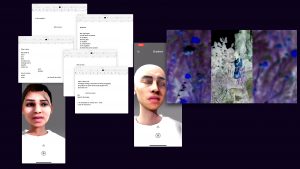
- 06.07.2022, from 6.30 pm
- 07.07.2022, from 6.30 pm
- 08.07.2022, from 5.30 pm
- 09.07.2022, from 2.00 pm
- 09.07.2022, at 4.00 pm / talk with Shahram Khosravi
- 10.07.2022, from 12.00 pm
Basel Abbas and Ruanne Abou-Rahme work together across a range of sound, image, text, installation and performance practices. Their practice is engaged in the intersections between performativity, virtuality, political imaginaries and the body. The work created for “Bodies, un-protected” is part of their examination of the place and the significance of voice (in the form of song and oral poetry) and body (in the form of dance and gesture) as a political act of embodiment in a moment marked by various forms of violence against entire living fabrics. The project repositions these moments as a material witness to the destruction of everyday life that is occurring or has occurred: moments that represent critical ways in which these fractured communities are resisting their own erasure and laying claim to space, self and community.
Single channel video, two channel sound
The presentation of the installation “After Everything Is Extracted” unfortunately has to be cancelled.
Biography
Basel Abbas
Basel Abbas and Ruanne Abou-Rahme work together across a range of sound, image, text, installation and performance practices. Their practice is engaged in the intersections between performativity, political imaginaries, the body and virtuality. Their approach has largely been one of sampling materials – both existing and self-authored – in the form of sound, image, text and objects, and recasting these into ‘scripts’ that are altogether new. The result is a practice that investigates the political, visceral and material possibilities of sound, image, text and site, taking on the form of multi-media installations and live sound/image performances.
Biography
Ruanne Abou-Rahme
Basel Abbas and Ruanne Abou-Rahme work together across a range of sound, image, text, installation and performance practices. Their practice is engaged in the intersections between performativity, political imaginaries, the body and virtuality. Their approach has largely been one of sampling materials – both existing and self-authored – in the form of sound, image, text and objects, and recasting these into ‘scripts’ that are altogether new. The result is a practice that investigates the political, visceral and material possibilities of sound, image, text and site, taking on the form of multi-media installations and live sound/image performances.